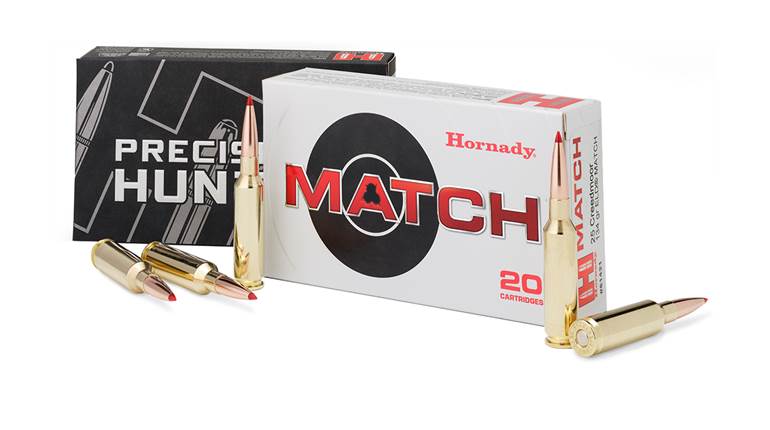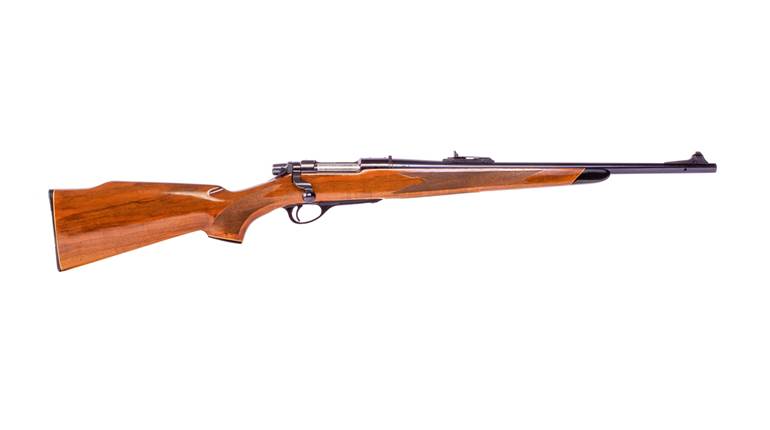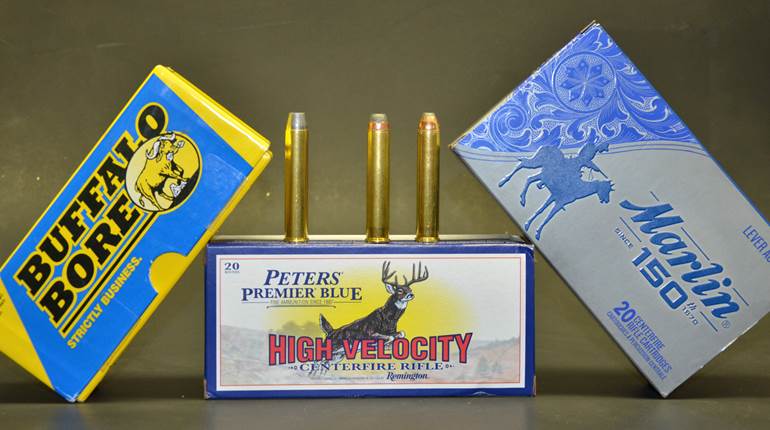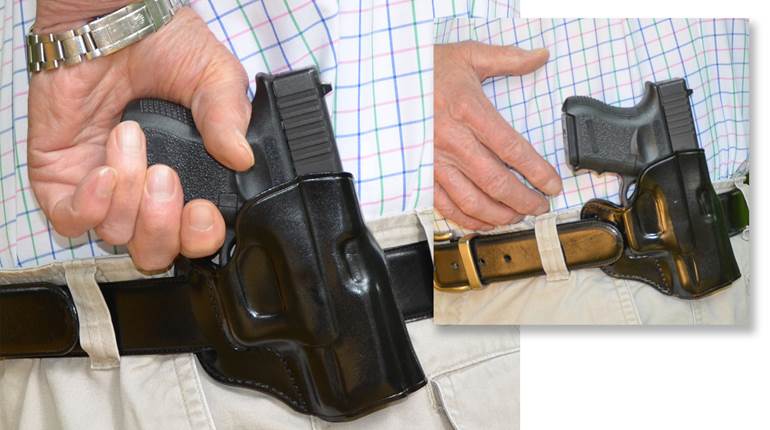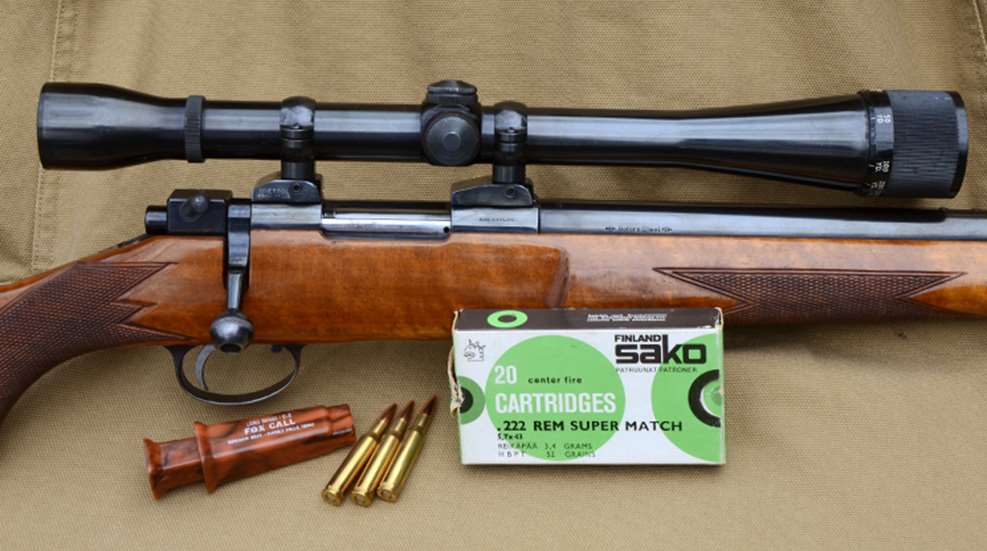
The author’s 1952-production Sako L46, chambered in .222 Rem. and topped with a Weaver K12 scope, is still accurate more than six decades after it was made.
The .222 Rem. cartridge, designed by Mike Walker of Remington, was introduced in 1950 in that company’s Model 722 rifle. The gun was only a couple of years old at the time, and it would soon be joined by others chambering the new cartridge. Sako, which began exporting its L46 rifle to the United States in 1949, added the .222 shortly after the gun’s introduction. My early example in .218 Bee has the thin barrel typical for those rifles, but my 1952-vintage .222 has the optional heavy barrel for that caliber.
Other rifles of both foreign and domestic manufacture followed, and finding an accurate one was not difficult. Among those I have shot through the years, Remington’s Models 722, 700, 600, 788 and 40X ranked highly in accuracy, as did several Sako L46 and L461 rifles.
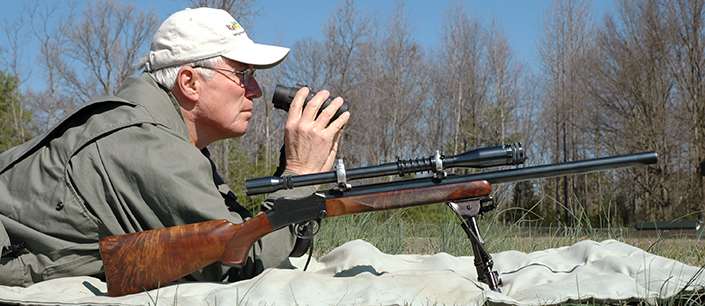
The Marlin 322 built on the Sako L46 action was quite nice, but accuracy was short-lived because of accelerated wear when its Micro-Groove rifling was subjected to jacketed bullets at high velocities. Other great .222s were the Browning Hi-Power and the Harrington & Richardson 317, both on the Sako L461 action, and the Anschutz Model 1533. The Savage 340 was the first economy-priced rifle offered in .222 Rem.
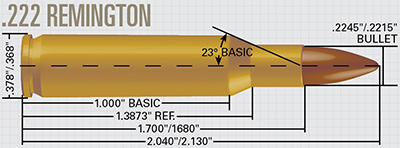 The .222 Rem. was the second commercially developed cartridge of its caliber to have a rimless case (the .22 Newton was first). And whereas most earlier .22 center-fires were descendants of existing cases of larger calibers, the .222 case was brand new. Early in its development, a 48-gr. bullet was loaded, but when performance on varmints proved to be unsatisfactory, a 50-gr. bullet with a thinner jacket became standard. A metal-case bullet of the same weight was also available. With a velocity of 3200 f.p.s., the .222 offered greater range than the .22 Hornet and longer barrel/accuracy life than the .220 Swift.
The .222 Rem. was the second commercially developed cartridge of its caliber to have a rimless case (the .22 Newton was first). And whereas most earlier .22 center-fires were descendants of existing cases of larger calibers, the .222 case was brand new. Early in its development, a 48-gr. bullet was loaded, but when performance on varmints proved to be unsatisfactory, a 50-gr. bullet with a thinner jacket became standard. A metal-case bullet of the same weight was also available. With a velocity of 3200 f.p.s., the .222 offered greater range than the .22 Hornet and longer barrel/accuracy life than the .220 Swift.
In addition to taking the varmint-shooting world by storm, the cartridge soon dominated a new shooting game called modern benchrest. Mike Walker, one of the founders of Int’l Benchrest Shooters, first shot the cartridge in competition at the Johnstown, N.Y., gun club during the summer of 1950. The rifle, built by him, had a heavy barrel and was on a Model 722 action. His five, five-shot groups at 100 yds. averaged 0.35", which was not bad in those days. As the accuracy of rifles and shooters improved, so did the .222, with sub-quarter-minute groups eventually becoming commonplace. The .219 Donaldson Wasp, .220 Wilson Arrow and other favorites eventually faded away.
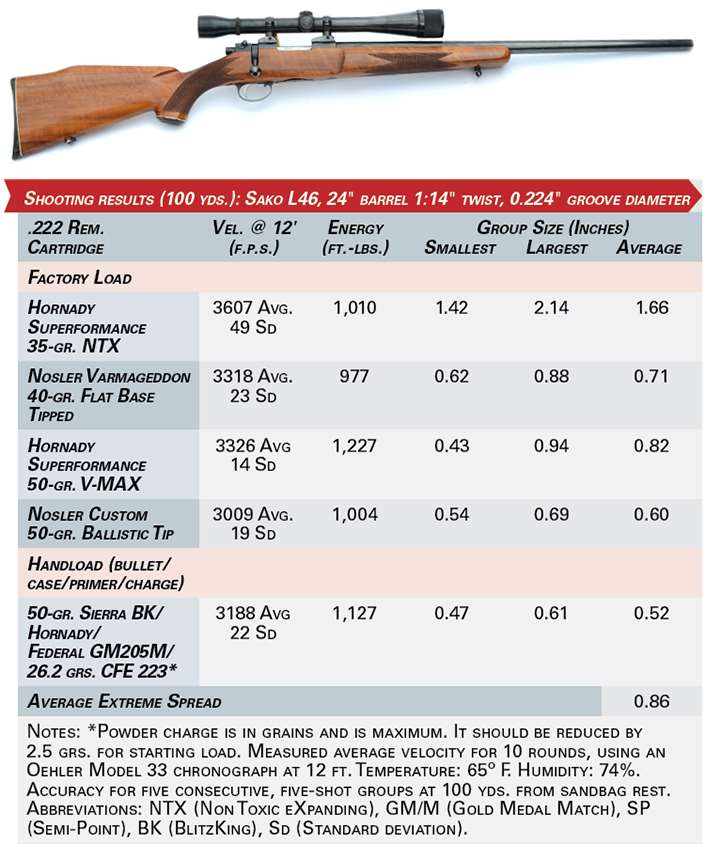
The rifle Walker used in that first match would evolve into Remington’s 40X target rifle. In .222 Rem., it was guaranteed to consistently average 0.45" and smaller for five shots at 100 yds., making it the most accurate factory rifle available at the time. Up until about the mid-1960s, the 40X and custom rifles on the Model 722 action dominated benchrest competition, but they began losing the accuracy race with the introduction of rifles built around custom actions from barrelmaker Ed Shilen and several others.
Benchrest was not the only competitive game in which the “Triple-Deuce” excelled. In 1960, the Remington Model 760 pump gun in .222 was adopted by the U.S. Army Marksmanship Unit at Ft. Benning, Ga., for use in 100-meter international running deer competition, where a moving target is exposed for only a few seconds. The highly modified rifles wore Redfield Int’l target sights and heavy, match-grade barrels. The first win came in 1961 when the Army team took gold during the double-shot aggregate at the world championship matches in Oslo, Norway. Back at Ft. Benning that same year, Sgt. Norman Skarpness won the single-shot (50 single-shots) championship while SFC Loyd G. Crow, Jr., took first honors in the double-shot (50 double-shots).
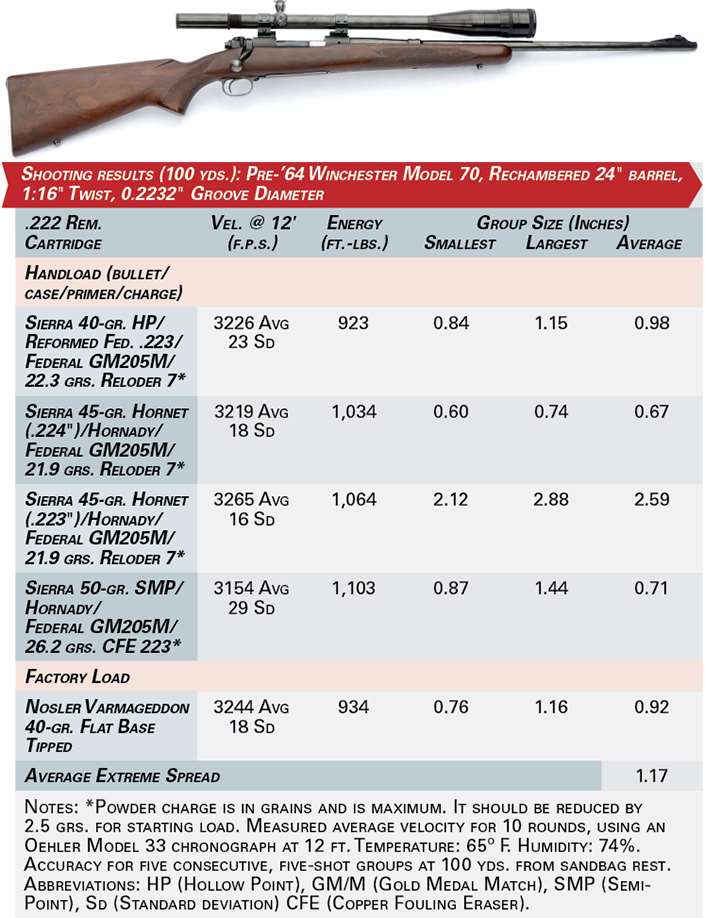
I doubt if many of today’s shooters are aware of the existence of a rimmed version of the .222 Rem. called the .222 Super. Martini-Henry rifles were used by various Australian armed forces and police forces beginning in 1871 with the .577/450 Martini-Henry cartridge and later ending with the .303 British. They were too large and heavy for comfortable use by young cadets at various schools and military academies, so a rifle on a smaller version of the Martini action was adopted. Chambered for a rimmed cartridge called the .310 Greener, they were manufactured by several English firms, including BSA Ltd.
When the Martini Cadet rifles became obsolete, the Australian government sold thousands to hunters and shooters in that country, many of which were converted to .22 Hornet and .218 Bee. Demand for higher velocity prompted the Super Cartridge Co. Pty. Ltd. of Maribyrnong, Victoria, to begin making a .222 with the same rim diameter as the .38 Spl. revolver cartridge. That made the case compatible with the extractor of the Martini rifle. Rifles were also exported to the United States where Ye Olde Hunter, a popular U.S. mail-order firm, priced a complete rifle at $15 and the action alone at $8.
After buying one of the actions, I learned that Williams Gunsight Co. of Davison, Mich., was importing .222 Super cases, and quickly stocked up. Then, my friend Dave Talley—an accomplished machinist and fine custom stockmaker who later made his mark manufacturing scope mounts—turned my $10 barrel blank from Herter’s, a stock and fore-end from Bishop, and a Unertl Varmint scope in 12X into in a fine little single-shot rifle in .222 Super.
The .222 Rem. is parent to other offspring as well, with the .222 Rem. Mag. introduced in 1958 being the first and the .22 TCM from Rock Island Armory being the latest. Others include the .221 Fireball, 5.56/.223 Rem., .17 Rem, .17 Fireball, .204 Ruger, .300 Blackout and the European-developed 5.6x50 mm Mag., which was introduced during the 1960s for use on roe deer.
There have also been a few wildcats with the 6x47 mm on the .222 Rem. Mag. case once used by benchrest shooters in Sporter Class where 6 mm and larger cartridges are required. It became popular enough to inspire Federal to offer unprimed, nickel-plated cases. Today the 6x45 mm is more popular due to the abundance of .223 Rem. brass. Black Hills loads 6x45 mm ammunition, and Les Baer Custom chambers the AR-15 for it. Also on the .223 Rem. case were the TCU line of unprimed cases in 6 mm, 6.5 mm and 7 mm.
Back to the .222 Rem., companies presently listing the ammunition include Federal, Hornady, HSM, Nosler, Prvi Partisan, Remington, Sellier & Bellot and Winchester. Plenty to keep the thousands of rifles out there active in the varmint fields, with one caveat. Production during the past few years has been devoted to more popular cartridges, resulting in a scarcity of .222 Rem. ammunition.
That should eventually change for the better, but in the meantime, the .222 has always been a great candidate for handloading. A top-ranked benchrest shooter who used a 50-gr. bullet once commented on using IMR-4198 for so long his powder measure adjustment was permanently stuck in place at 20.5 grs. Holding a strong second place in popularity was Bruce Hodgdon’s first lot of military-surplus BL-C. Its eventual replacement, BL-C(2), never became as popular. H322 and Reloder 7 have long been excellent choices and, as newer propellants go, Reloder 10X and VihtaVuori N130 are worthy of a try. CFE 223 is a good choice with 50-gr. and heavier bullets. Any good, small rifle primer will light the fire, but I am partial to the Federal GM205M and the CCI BR4.
When unprimed cases cannot be found, simply run .223 Rem. brass through a .222 Rem. full-length resizing die and trim to a length of 1.690". Either virgin or once-fired cases should be used.
The .222 Rem. ruled over benchrest competition until the 1970s when it and the 6x47 mm were replaced by the 6 mm PPC. In the varmint fields it eventually lost out to the .223 Rem., mainly because cartridges adopted by the U.S. military have historically run roughshod over their competition. Those in the market for a new varmint rifle chambered for an extremely accurate and mild-mannered cartridge will logically choose the .223 Rem. due to more variety in factory ammunition and more availability of cases for reloading. But those of us who already own rifles in .222 Rem., and enjoy reliving the past, would not dream of switching.
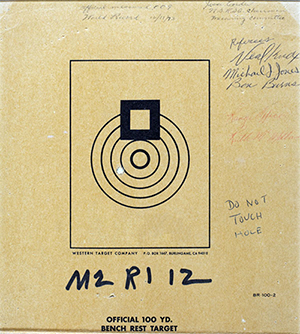 A World Record Group
A World Record Group
Despite the 6 mm PPC’s dominance in 100- and 200-yd. benchrest competition for nearly three decades, it has yet to topple the .222’s firm hold on the world’s smallest group. That accomplishment was shot by Mac McMillan on Sept. 23, 1973, during a NBSRA-sanctioned match at the Skunk Creek rifle range near Phoenix, Ariz. Chambered in .222 Rem., the 10½-lb. Light Varmint class rifle had an action built by Mac, a barrel made by brother Pat and a fiberglass stock made by another brother, Gale. Wally Siebert had bumped the magnification of its 12X scope to 24X. Custom dies were used to swage 50-gr. bullets using J4 jackets. McMillan’s load consisted of the Remington case, 23.5 grs. of Hodgdon BL-C (Lot No. 1) and an experimental primer made by CCI that would become the BR4.
McMillan’s five-shot, 100-yd. group was measured by match officials with a dial caliper modified by the addition of a clear plexiglass plate containing a .22-cal. reticle. All bullet holes in the paper target fit inside the reticle for an incredible group-size measurement of 0.0000". For the first time in recorded history, the perfect “one-hole” group had been shot in registered competition. The group was next measured with a special 60X microscope capable of accuracy to 0.0001", and it still came out at 0.0000". As required for official recognition, the target was then mailed around to seven members of the NBRSA records committee and they unanimously agreed on 0.009" as the size of the group. The group stood for 40 years until Mike Stinnett beat it by 0.002" with a 30 PPC in 2013.
—Layne Simpson
Those Rechambered .22 Hornets
During the 1950s and 1960s, practically every varmint shooter in the country wanted a rifle in .222 Rem. Factory rifles were available, but for less money that old .22 Hornet standing in the corner could be rechambered. And many were, not only by one-man shops, but by bigger operations such as Griffin & Howe. Two of the more popular for the conversion were Winchester’s Models 54 and 70. Whereas the rifling twist rate of 1:16" in their barrels was usually a bit slow for best accuracy with bullets heavier than 45 grs. at .22 Hornet velocities, the 50-gr. bullet originally loaded by Remington in the .222 Rem. was marginally stabilized in flight due to its higher velocity. Some rifles shot it accurately, others did not.
The Model 70 I have had for about 25 years (opposite page) is a standard grade with a 24" barrel. A previous owner had P.O. Ackley modify it soon after the .222 Rem. was introduced. Making the change required making a new magazine follower and modifying the bolt so that, as it moves forward, a hinged arm drops down to push the tiny .22 Hornet cartridge from a magazine capable of handling cartridges as large as the .375 H&H Mag. When enlarging the bolt face for the .222, the pusher was eliminated.
Barrel groove diameter of the Winchester rifles usually measures a nominal 0.223", and since they deliver acceptable accuracy with the 0.224" bullets of .22 Hornet factory ammunition, the same can be expected for bullets of the same diameter from the .222 Rem. The 1:16" twist does place limitations on bullet length. As an example, the Sierra 50-gr. BlitzKing measuring 0.780" long is unstable in flight while the shorter (0.633" long) Sierra 50-gr. SMP is quite accurate.
Dropping back to 40 grs. and lighter is not a total solution because some are quite long for their weight, and only slight differences can matter. My Model 70 is extremely accurate with the Nosler 40-gr. FB Tipped that measures 0.670", but groups open up with the Hornady 40-gr. V-MAX measuring a slightly longer 0.680" and even more so with the 0.700" long Nosler 40-gr. Ballistic Tip. The Hornady 35-gr. NTX at 0.725" and the Nosler 40-gr. Lead Free Ballistic Tip at 0.780" won’t stay on a 16x16" target at 100 yds.
Other bullets that do work in my rifle are the Hornady 35-gr. V-MAX, Sierra 40-gr. HP, Nosler 40-gr., Varmageddon HP, the Sierra 40- and 45-gr. Hornet and the Hornady 45-gr. Hornet. The Hornet bullets from Sierra are available in 0.223" and 0.224" with the larger diameter being considerable more accurate in my Model 70 with its 0.2232" groove diameter.
If bullets of the two diameters are tried, use a Redding Type S full-length sizing die with interchangeable bushings and install a bushing 0.002" smaller than the neck diameter of a loaded round. To assure adequate case neck tension, the neck expander button of a sizing die made for 0.224" bullets measures 0.223" and it should be 0.222" for 0.223" bullets. This can be accomplished by reducing button diameter or by ordering one of the desired size from the die manufacturer.
Factory ammunition options for a 1:16" twist barrel are quite limited. The best I have tried is Nosler Varmageddon loaded with that company’s 40-gr. Flat Base Tipped bullet. No currently available .222 Rem. factory load with a 50-gr. bullet that I have tried delivers acceptable accuracy from my Model 70.
—Layne Simpson












